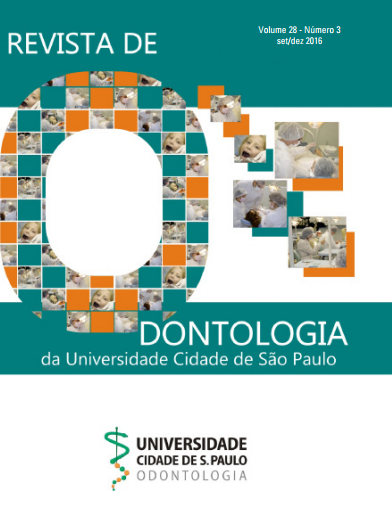Utilização de pilares cerâmicos em prótese sobre implante: revisão de literatura
DOI:
https://doi.org/10.26843/ro_unicid.v28i3.208Palavras-chave:
Estética dentária, Implantes dentários, Dente.Resumo
A implantodontia sofreu muitos avanços na Odontologia moderna. As restaurações estéticas implanto-suportadas em dentes anteriores tornaram-se desafiadoras, pois os pilares protéticos utilizados para reter as próteses sobre implante são geralmente de titânio ou outros metais. Percebeu-se que esses implantes levam a uma coloração azul-acinzentada aos tecidos moles em pacientes com sorriso gengival ou biótipo fino. Para solucionar esse problema, pilares em cerâmica de zircônia ou alumina podem ser utilizados para permitir a eliminação de intercorrências quanto à cor e brilho metálico através do tecido peri-implantar. O resultado benéfico e a melhor adaptabilidade biológica e funcional estimulam o uso desses materiais. Esta revisão teve como finalidade descrever as principais características dos pilares cerâmicos, vantagens e desvantagens em relação aos metálicos, além das suas propriedades funcionais e biológicas.Downloads
Referências
. Branemark PI. Osseointegration and its experimental background. The Journal of prosthetic dentistry 1983 Sep;50(3):399-410.
Bidra AS, Rungruanganunt P. Clinical outcomes of implant abutments in the anterior region: a systematic review. Journal of esthetic and restorative dentistry : official publication of the American Academy of Esthetic Dentistry [et al] 2013 Jun;25(3):159-76.
Blatz MB, Bergler M, Holst S, Block MS. Zirconia abutments for single-tooth implants--rationale and clinical guidelines. Journal of oral and maxillofacial surgery : official journal of the American Association of Oral and Maxillofacial Surgeons 2009 Nov;67(11 Suppl):74-81.
Yildirim M, Edelhoff D, Hanisch O, Spiekermann H. Ceramic abutments--a new era in achieving optimal esthetics in implant dentistry. The International journal of periodontics & restorative dentistry 2000 Feb;20(1):81-91.
Zembic A, Sailer I, Jung RE, Hammerle CH. Randomized-controlled clinical trial of customized zirconia and titanium implant abutments for single- -tooth implants in canine and posterior regions: 3-year results. Clinical oral implants research 2009 Aug;20(8):802-8.
Nothdurft F, Pospiech P. Prefabricated zirconium dioxide implant abutments for single-tooth replacement in the posterior region: evaluation of peri-implant tissues and superstructures after 12 months of function. Clinical oral implants research 2010 Aug;21(8):857-65.
Jiménez-Melendo M, Llena-Blasco O, Bruguera A, Llena-Blasco J, Yáñez- -Vico R-M, García-Calderón M, et al. Mechanical behavior of single-layer ceramized zirconia abutments for dental implant prosthetic rehabilitation. Journal of Clinical and Experimental Dentistry 2014;6(5):e485-e90.
Att W, Kurun S, Gerds T, Strub JR. Fracture resistance of single-tooth implant- -supported all-ceramic restorations: an in vitro study. The Journal of prosthetic dentistry 2006 Feb;95(2):111-6.
Zembic A, Bosch A, Jung RE, Hammerle CH, Sailer I. Five-year results of a randomized controlled clinical trial comparing zirconia and titanium abutments supporting single-implant crowns in canine and posterior regions. Clinical oral implants research 2013 Apr;24(4):384-90.
Piconi C, Maccauro G. Zirconia as a ceramic biomaterial. Biomaterials 1999 Jan;20(1):1-25.
Glauser R, Sailer I, Wohlwend A, Studer S, Schibli M, Scharer P. Experimental zirconia abutments for implant- -supported single-tooth restorations in esthetically demanding regions: 4-year results of a prospective clinical study. The International journal of prosthodontics 2004 May-Jun;17(3):285-90.
Yuzugullu B, Avci M. The implant- -abutment interface of alumina and zirconia abutments. Clinical implant dentistry and related research 2008 May;10(2):113-21.
Sailer I, Zembic A, Jung RE, Siegenthaler D, Holderegger C, Hammerle CH. Randomized controlled clinical trial of customized zirconia and titanium implant abutments for canine and posterior single-tooth implant reconstructions: preliminary results at 1 year of function. Clinical oral implants research 2009 Mar;20(3):219-25.
Gehrke P, Tabellion A, Fischer C. Microscopical and chemical surface characterization of CAD/CAM zircona abutments after different cleaning procedures. A qualitative analysis. The Journal of Advanced Prosthodontics 2015;7(2):151-9.
Rimondini L, Cerroni L, Carrassi A, Torricelli P. Bacterial colonization of zirconia ceramic surfaces: an in vitro and in vivo study. The International journal of oral & maxillofacial implants 2002 Nov-Dec;17(6):793-8.
Borges T, Lima T, Carvalho Á, Carvalho V. Clinical Outcome of Inter-Proximal Papilla between a Tooth and a Single Implant Treated with CAD/ CAM Abutments: a Cross-Sectional Study. Journal of Oral & Maxillofacial Research 2012 Jul-Sep;3(3):e4.
De Medeiros RA, Vechiato-Filho AJ, Pellizzer EP, Mazaro JV, Dos Santos DM, Goiato MC. Analysis of the peri- -implant soft tissues in contact with zirconia abutments: an evidence-based literature review. The journal of contemporary dental practice 2013 May 01;14(3):567-72.
Vigolo P, Fonzi F, Majzoub Z, Cordioli G. An in vitro evaluation of ZiReal abutments with hexagonal connection: in original state and following abutment preparation. The International journal of oral & maxillofacial implants 2005 Jan-Feb;20(1):108-14.
Happe A, Schulte-Mattler V, Fickl S, Naumann M, Zoller JE, Rothamel D. Spectrophotometric assessment of peri-implant mucosa after restoration with zirconia abutments veneered with fluorescent ceramic: a controlled, retrospective clinical study. Clinical oral implants research 2013 Aug;24 Suppl A100(28-33.
Jung RE, Sailer I, Hammerle CH, Attin T, Schmidlin P. In vitro color changes of soft tissues caused by restorative materials. The International journal of periodontics & restorative dentistry 2007 Jun;27(3):251-7.

